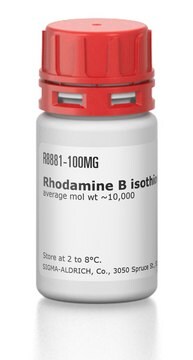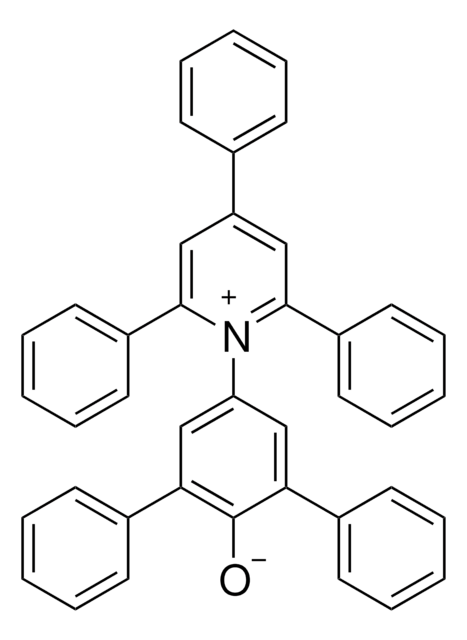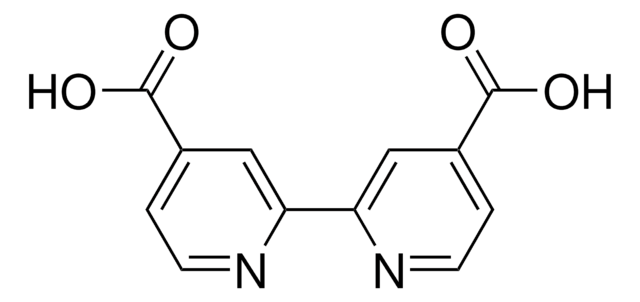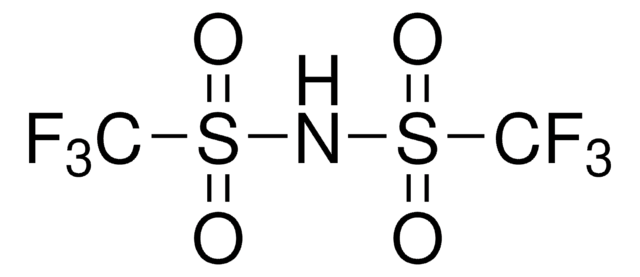Key Documents
791415
K19 Dye
85% (HPLC)
Synonim(y):
Greatcell Solar®, K 19 sensitizer, Ru(4,4-dicarboxylic acid-2,2′-bipyridine)(4,4′-bis(p-hexyloxystyryl)-2,2-bipyridine)(NCS)2
About This Item
Polecane produkty
Próba
85% (HPLC)
Postać
powder (black)
mp
>300 °C
λmaks.
536, 357, 311 nm at 0.02 mM in DMF (lit.)
ciąg SMILES
OC(C1=CC(C2=CC(C(O)=O)=CC=N2)=NC=C1)=O.S=C=N[Ru]N=C=S.CCCCCCOC(C=C3)=CC=C3/C=C/C4=CC=NC(C5=NC=CC(/C=C/C6=CC=C(OCCCCCC)C=C6)=C5)=C4
InChI
1S/C38H44N2O2.C12H8N2O4.2CNS.Ru/c1-3-5-7-9-27-41-35-19-15-31(16-20-35)11-13-33-23-25-39-37(29-33)38-30-34(24-26-40-38)14-12-32-17-21-36(22-18-32)42-28-10-8-6-4-2;15-11(16)7-1-3-13-9(5-7)10-6-8(12(17)18)2-4-14-10;2*2-1-3;/h11-26,29-30H,3-10,27-28H2,1-2H3;1-6H,(H,15,16)(H,17,18);;;/q;;2*-1;+2/b13-11+,14-12+;;;;
Klucz InChI
HBARXZGSEMEPLK-BPSJQPAOSA-N
Opis ogólny
Zastosowanie
Informacje prawne
Greatcell Solar is a registered trademark of Greatcell Solar Materials Pty Ltd.
Hasło ostrzegawcze
Warning
Zwroty wskazujące rodzaj zagrożenia
Zwroty wskazujące środki ostrożności
Klasyfikacja zagrożeń
Eye Irrit. 2 - Skin Irrit. 2 - Skin Sens. 1 - STOT SE 3
Organy docelowe
Respiratory system
Kod klasy składowania
11 - Combustible Solids
Klasa zagrożenia wodnego (WGK)
WGK 3
Temperatura zapłonu (°F)
Not applicable
Temperatura zapłonu (°C)
Not applicable
Wybierz jedną z najnowszych wersji:
Certyfikaty analizy (CoA)
Nie widzisz odpowiedniej wersji?
Jeśli potrzebujesz konkretnej wersji, możesz wyszukać konkretny certyfikat według numeru partii lub serii.
Masz już ten produkt?
Dokumenty związane z niedawno zakupionymi produktami zostały zamieszczone w Bibliotece dokumentów.
Klienci oglądali również te produkty
Produkty
Dye-sensitized solar cells (DSCs) are 3rd generation solar cells combining the promise of high efficiency with low production costs.
While dye sensitization as the basis for color photography has been accepted for a very long time,1 attempts to use this principle for the conversion of solar light to electricity generally had resulted only in very low photocurrents, below 100 nA/cm2.2
Nasz zespół naukowców ma doświadczenie we wszystkich obszarach badań, w tym w naukach przyrodniczych, materiałoznawstwie, syntezie chemicznej, chromatografii, analityce i wielu innych dziedzinach.
Skontaktuj się z zespołem ds. pomocy technicznej













